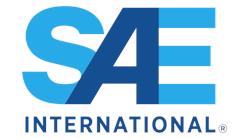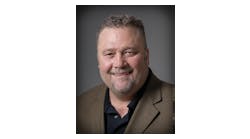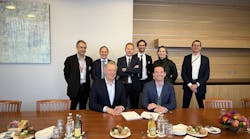To design and build quality ground support equipment, GSE manufacturers adhere to industry standards and specifications. Those standards are developed by a group of volunteers with the goal of making ground operations safer.
The SAE AGE-3 Aircraft Ground Support Equipment committee addresses all aspects of airport, GSE and associated systems that “interface or require compatibility with the aircraft.”
The committee has five objectives, including developing and maintaining technical standards, specifications and reports related to GSE and ground services; providing a forum for exchanging technical information related to ground ops to address and solve issues; coordinating and harmonizing worldwide standards development with other standardization groups; promoting the global use of high quality standards and practices; and promoting research and innovation in any topics related to the scope of the committee.
Original equipment manufacturers (OEMs), ground handlers, airlines, suppliers and consulting firms are among the participants in the SAE AGE-3 committee.
Purpose of the Committee
SAE International, which was founded in the early 20th century, is a professional standards organization for engineering professionals in various industries. SAE develops and publishes technical standards based on best practices identified and described by SAE technical committees across various industries, including aerospace.
“What we produce are called voluntary standards. They don’t carry the force of law,” says Scott Barninger, AGE-3 committee chairman and director of GSE at Piedmont Airlines. “The way these standards get enforced is I, as a consumer – an airline user, tell you, the manufacturer of GSE, that I want to buy your stuff, but you have to conform to SAE.
“OEM manufacturers typically look to the SAE specs when designing their products because people want to know that they’re compliant,” he adds.
In addition to the SAE, the International Air Transport Association (IATA), the International Organization for Standardization (ISO) and the European Committee for Standardization (CEN) also create standards pertaining to GSE.
“They’re different groups with different rationales,” Barninger says. “SAE does specific design specifications for building something to meet that functional need.”
To create and adopt these standards, the AGE-3 committee gathers input from all stakeholders in the ground support industry – from GSE manufacturers to airline representatives and ground handlers. This also means competitors are working together on manufacturing specifications. But as John Moore, AGE-3 committee member and CEO at PAGE GSE, notes, this collaboration is for the good of the industry.
“It’s not a dictatorship,” he says. “It’s input from everybody.
“We start from scratch, from the ground up, in a lot of cases,” Moore adds. “It’s best to get every aspect of input for that in order to get it right without having to re-invent the wheel every time.”
Ruddy Castillo, AGE-3 committee member and vice president of product development at Sage Parts, points out that ground support is a small industry, and because of the industry’s size, specific decisions have direct impacts an many players.
“What one element does, or what one component does, affects all of us. So, it makes sense to bring all of us together with different perspectives, different ideas and different opinions,” he says.
“There’s a lot of collaboration that’s necessary in order for this type of group to be successful,” Castillo continues, noting a large portion of the AGE-3 committee members have a technical background. “You have to have an open mind, of course, challenge where challenge is needed and also learn.”
Committee Objectives and Processes
Previously, standards for ground support equipment were addressed by the AGE-2C Vehicle Maintenance and Aircraft Servicing committee. That group was a subcommittee of the AGE-2 Air Cargo and Aircraft Ground Equipment and Systems committee
“Once upon a time, there was a committee – AGE-2,” Barninger says. “And it had two subcommittees – 2A, which was cargo and 2C, which was GSE.”
Because of the specific nature of the GSE standards, Barninger explains the subcommittee sought approval from the SAE to form a separate committee. This allowed the GSE committee to ballot documents independently.
The AGE-2C subcommittee became the AGE-3 Airport Ground Support Equipment committee and the AGE-2A cargo portion became the AGE-2 Air Cargo committee. The GSE standards group further evolved when the Aircraft Ground Deicing Steering Group split away from AGE-2C to form its own specific committee known as G12.
“We’re basically AGE-2C related and elevated from a subcommittee status to a full committee status,” Barninger says. “In other words, our ballots go straight to Aerospace Council now. Whereas, before they had to go through AGE-2 ballot and then to Aerospace Council.”
The SAE thoroughly outlines the process for creating, modifying and approving committee documents.
To facilitate the AGE-3 group, the SAE assigns a committee manager. As SAE’s Aerospace/SMC committee manager (CM), Kelly Sassaman’s role with the AGE-3 meetings is multifaceted.
“A committee manager works with the committee leadership prior to the meeting to ensure agendas are created and provided to participants in a timely manner for review prior to the event. Agendas are needed to justify travel requirements for many participating companies. The CM also provides assistance with information distribution about the event logistics, clerical support for committee information collection and posting and obtaining documents that are up for review,” Sassaman says.
“However, one of the biggest roles of the CM during an AGE-3 committee meeting or document creation is to ensure that the process and procedures of the SAE Aerospace Council are being adhered to,” she adds. “This involves answering committee member questions about voting, document verbiage, intellectual property rules, copyright procedures and directing participants to the appropriate contacts within the SAE organization when needed.”
What’s more, Sassaman explains CMs coordinate inter-committee collaboration when topics cross over committees. The position also requires supporting committee participants in using the technology platforms for voting and commenting on documents, as well as technology onsite at meeting locations.
Once a meeting begins, the objective is to move the industry forward with facts, discussion and collaboration.
“It’s as data-driven as possible,” Castillo says. “You go off and do your homework. Then you come and present it to the committee. The whole premise is that your opinion is only as valuable as someone’s ability to repeat it later or be able to produce the same result.”
Although volunteering in the AGE-3 committee requires an investment in time, energy and resources – from both a corporate and personal level, Castillo says participating in the group is worthwhile.
“It’s valuable in the sense that you get to be at the forefront of these topics that are going to affect your industry,” he says. “We’re at the table when discussions are being had about where the industry is going and what are the challenges – from safety all the way up to new technology that’s coming into the industry. This is the forum to participate in that.”
Joining the Committee
There are three ways to participate in the AGE-3 committee: as a mailing list member, as a liaison and as a voting member.
“SAE committees are open to the public,” Sassaman says. “Information about each committee can be found on the SAE website. If a person is interested in becoming involved with a committee, the individual completes a ‘join committee’ form and is entered into the SAE system as either a mail list, liaison or voting member.”
Voting members contribute to the work of a technical committee, vote on all technical report ballots and maintain active participation on a respective technical committee. Liaisons coordinate with parallel activities occurring in the government, other associations and related SAE technical committees and may serve in an advisory capacity on specific projects. Liaisons receive technical report ballots and may provide comments. However, they do not have an approval/disapproval vote. Mailing list recipients receive information on technical committee meetings. They do not receive information related to technical report ballots.
“If you’re only interested in receiving email communications from the committee about upcoming events, ballots or whatever, you’re just on the mailing list,” Barninger adds. “Liaison is probably the majority of our members. A liaison member has access to the standards works website. They can view all the committee documents. They can participate in a ballot to the extent that they can read the draft and they can enter comments about the draft.”
After exclusively holding virtual meetings during the pandemic, the AGE-3 committee has returned to its previous method of holding two annual meetings – once in person and once virtually.
Convening in the same physical location comes with benefits.
“In-person committee meetings provide community building amongst the members. Face-to-face conversations are not inhibited by poor internet connectivity. Members can read facial expressions of their peers and flow points of discussion. A quick hallway chat can resolve a ballot comment that has been lingering over email responses,” Sassaman says. “In-person meetings help encourage new standards ideas through presentations from different industry stakeholders.”
The current members of the AGE-3 committee are looking for more participation. Moore notes volunteers are needed from all facets of the industry.
“No one in here is selling a product. We’re trying to make our industry better as a whole,” Moore says.
“I would hope that the different facets of the industry – the manufacturers, the airlines, the ground handlers and the GSE manufacturers – know that there’s an opportunity to join a group at a ground level to influence and be a part of the direction the industry is headed,” he adds.
Moore says he joined the committee because he wanted to better understand the ins and outs of the industry.
“These were all the brains in the industry from the engineering world. In order to be able to talk the talk and walk the walk, I wanted to get emersed with these folks, and I’ve stayed here,” Moore says.
Moore encourages people to review the committee agendas to see if there is an area of expertise they can contribute to. He also notes the meetings are free.
“We’re sponsored, normally by manufacturers,” Moore says. “Because of that there’s no membership charge to come give your opinion and participate.”
Barninger says many people discover the AGE-3 committee by word of mouth. Others get involved because they’re using a standard in their work and think it can be improved.
“So, they’ll contact us with suggestions to improve it,” he says.
“If you have an interest in this industry, we look for members – not just from the engineering community, designing and building the equipment – but from the airline community, the people using the equipment and from the airframe OEMs because the equipment is being designed to work on them,” Barninger says. “The more we can get from that mix of people, the better the standards are going to be.
“So anybody involved in any one of those categories and has an interest in working on standards, I would encourage them to contact us.”
“There’s dedicated people here because we know that if we can get it right here, then there’s more time at home later. There’s a lot less problems in the future,” Moore adds.
Industry members who would like to join can also contact SAE directly for more information about the AGE-3 committee and submit an inquiry with the committee manager.
“GSE is a very small community. It’s a tight-knit, little world. Most of us who are in this business, who have been going to these meetings for years, we all know each other. Sometimes we change chairs, sometimes we change companies, but we all know each other,” Barninger says. “It’s a close networking group.”






